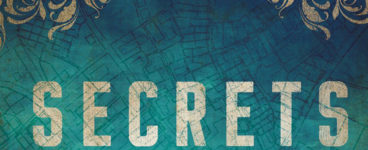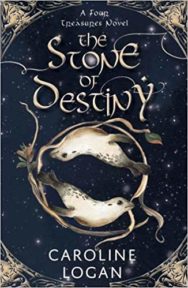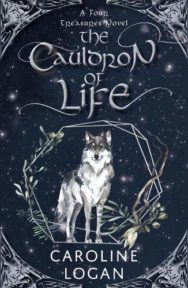‘The characters journey through the woods and, if I was ever lacking inspiration, I could just take my dogs for a walk in the forest.’
Caroline Logan began her fantasy YA series, Four Treasures, with last year’s The Stone of Destiny. On publication of the next instalment of the series, The Cauldron of Life, BooksfromScotland got in touch to ask Caroline to tell us more about the series and her writing.
The Cauldron of Life
By Caroline Logan
Published by Cranachan
Congratulations, Caroline – you’ve just published the 2nd book in the Four Treasures series. For those people who still haven’t found themselves in the world of Eilanmor, can you tell readers what to expect from the series and from the The Cauldron of Life?
The Four Treasures series is based on Scottish mythology. Book one, The Stone of Destiny, followed Ailsa MacAra, a social outcast, who got roped into finding a magical stone by two insistent selkies. If you’ve read the book, you’ll know that there was a lot more to the story. I always have people saying: ‘but there’s 100 pages left, what’s going to happen?’ Basically Ailsa’s world was turned upside down and The Cauldron of Life is about her journey to find out who she really is. I’ve heard people say The Cauldron of Life is darker and has higher stakes than The Stone of Destiny. I guess that’s the benefit of a sequel: I’ve already introduced the characters, so now we get to go deeper into the world.
Your books are inspired by Scottish myth and legend. How did your interest there grow? Were you imagining faeries and selkies when you were young too?
Actually, I didn’t really know about Scottish mythology when I was young. I think we hear about so many English and Welsh or even Greek myths but not so much of ours. In fantasy books and movies, we tend to find dragons and mermaids, but never selkies and kelpies. So when I decided I wanted to try writing my own book, I tried to find out more about Scottish legends. I feel very grateful that I get to write about those stories as a Scottish person – they feel like my heritage.
How do you tackle writing about the past—even a fantastical past—for a modern audience?
I have a confession to make: originally I wanted to write a historical fantasy novel, but I found the research too difficult. I worried that I wouldn’t get things right since I don’t have a history degree, so I decided to just make up my own world based on Scotland. I’m really glad I did because it means I can have kilts and curry and beautiful dresses – things that wouldn’t have existed in a medieval setting. A lot of YA Fantasy is written like that, drawing on the past for inspiration but not holding itself to accuracy. It’s more entertaining, and at the end of the day that’s what a story should be.
The Four Treasure books form a series. Do you know what’s going to happen in the future books? Have you always known how the series will end? How do you tackle pacing in a series as well as a single novel?
When I first started writing The Stone of Destiny, I imagined all the things that will happen in the series in one book, but I quickly realised the story was too big for that. It grew to a duology, then a trilogy and then a four book series. Four is my lucky number anyway. From the beginning, I’ve had all four books plotted out, but I do add some things as I go. I know exactly what will happen in each of the books. That means I can drop in some little Easter eggs as I go. For example, someone walks past in Book one that you’ll eventually meet in Book three. In terms of pacing, I just try to have a number of peaks and troughs and I like to keep the pace up. No one wants to read about a return journey – the characters have already been there. So I just skip time a bit and add in some more action!
What is it about the fantasy genre that you think excites young readers?
I think everyone hopes that the world is a magical place, but sometimes we need to escape into books. Fantasy provides that fantastical escape and is so different to daily life. The stories are epic and inspiring. Personally, I love being spooked, and fantasy also has that ability. While things can be beautiful, they’re often also deadly.
What were your favourite books as a teen reader?
I really loved The Wind on Fire series by William Nicholson and The Chronicles of Narnia by C. S. Lewis, plus Noughts and Crosses by Malorie Blackman. Towards my later teen years I became obsessed with Dan Brown’s books – I love a bit of symbology and art history. I tried to write about Angels and Demons in a Higher English essay but my teacher was having none of it. She said his writing wasn’t good. Maybe I should have listened to her as I got a C in the final exam.
As well as writing, you teach high school biology. What do your pupils think of your books? Does your teaching inspire your writing?
A surefire way to get me flustered is for one of my pupils or co-workers to tell me they’ve read my book. I definitely separate those two parts of myself so when the worlds collide it feels very strange. Thankfully, most pupils have been really complimentary. I hope it’s inspiring for some of them to know that you can do one thing for your day job and also have a creative outlet. They have asked me before if I’m going to give up teaching but, aside from it not paying well, I don’t know if I could give up seeing them everyday. I’m very proud of all of them.
Does your expertise in science find itself in your writing?
Yes, absolutely. I like to know that what I’m writing about has a little bit of science to back it up. You see it a lot more in The Cauldron of Life; there’s a character who is a healer and all of the things he says are based on fact. Also, I studied Geography during my first year of university and I definitely drew from that when I was drawing my map.
You live in the Cairngorms National Park area. How does your surroundings influence your novels?
I started writing The Stone of Destiny when I lived in Campbeltown and you can see how that environment inspired the first part of the book. There are sandy beaches, caves and the churning sea. At one point when I lived there I did part of The West Highland Way and that made it into the book too. Now that I live in the Cairngorms, I think you can really see a shift in the landscape in The Cauldron of Life. The characters journey through the woods and, if I was ever lacking inspiration, I could just take my dogs for a walk in the forest.
What books have got you through this year’s lockdown experience?
I’ve really struggled with reading this year. Maybe it’s a side effect of all the worry the pandemic has brought? I did race through Stay Sexy and Don’t Get Murdered by Georgia Hardstark and Karen Kilgariff and also The Raven and The Dove by Kaitlyn Davis. To be honest, I listen to podcasts every second I get. I cannot get enough. I reckon it’s almost the same as listening to an audiobook, right? My favourites are Let’s Get Haunted, My Favourite Murder, Wine and Crime, Lore, And That’s Why We Drink and Morbid. There’s a theme there: I love true crime and spooky stories. I’ve found a lot of inspiration in them and I am absolutely addicted. Maybe soon I’ll manage to break my book slump and I’ll go back to reading again.
The Cauldron of Life by Caroline Logan is published by Cranachan, priced £8.99.
ALSO IN THIS ISSUE

 Fear in the World
Fear in the World
‘Then she did something incredible, something she too found hard to believe: in spite of her fright …

 Secrets She Kept
Secrets She Kept
‘”You’ve done a splendid job. But I just can’t stop thinking about the reason I came here in the fir …














